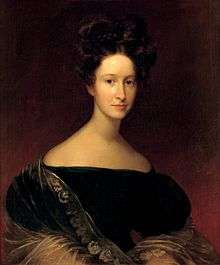Emily Donelson
| Emily Donelson | |
|---|---|
 | |
| First Lady of the United States De facto | |
|
In role March 4, 1829 – November 26, 1834 | |
| President | Andrew Jackson |
| Preceded by | Louisa Adams |
| Succeeded by | Sarah Jackson (De facto) |
| Personal details | |
| Born |
June 1, 1807 Donelson, Tennessee, U.S. |
| Died |
December 19, 1836 (aged 29) Nashville, Tennessee, U.S. |
| Spouse(s) | AJ Donelson (1824–1836) |
| Alma mater | Nashville Female Seminary |
Emily Donelson (June 1, 1807 – December 19, 1836) was the niece of Rachel Donelson Jackson, the wife of U.S. President Andrew Jackson.[1] She served as White House hostess and de facto First Lady of the United States.[1]
Early life and marriage
Emily Tennessee Donelson was born on her father's farm in Donelson, Tennessee. Her father, John Donelson, was the brother of Rachel Donelson Jackson, the wife of future President Andrew Jackson. Unlike many girls of her day, Emily was afforded a formal education. She studied at Nashville Female Academy in Nashville, with her niece Mary Ann Eastin, and was considered an accomplished student.
On September 16, 1824, seventeen-year-old Emily married A. J. Donelson. Donelson was Emily's first cousin and a ward of their mutual uncle and aunt, Andrew and Rachel Donelson Jackson.
White House hostess
It has been speculated that even before Rachel Donelson Jackson's death in 1828, Jackson had planned for Emily to accompany them to Washington to assist Rachel in the duties of White House hostess. The Jacksons had maintained a similar arrangement with Emily at The Hermitage, their plantation in Tennessee. The death of Rachel Donelson Jackson caused these plans to be abandoned and Andrew Jackson asked Emily to take over all the responsibilities of the White House hostess, which she did with the aid of her niece, Mary Ann Eastin.[1]
She arrived in Washington at the age of 21. Her husband, A. J. Donelson, served as President Jackson's private secretary. The first months of Jackson's administration marked a period of mourning for Rachel Donelson Jackson. The unofficial period of mourning ended when Emily hosted a New Year's party at the White House on January 1, 1830.
Petticoat affair and dismissal
In 1829, Washington society began to buzz with rumors surrounding Peggy Eaton, the new wife of Secretary of War John Henry Eaton. The rumors alleged the couple's relationship had begun as an extramarital affair, and that Peggy's first husband had committed suicide when he learned of their relationship.
The growing scandal, soon to be nicknamed the Petticoat affair, began to split Jackson's Cabinet. The wives of several members of Jackson's cabinet, most notably Floride Calhoun, the wife of Vice-President John C. Calhoun refused to receive Peggy into Washington society, and snubbed the couple.
President Jackson viewed the treatment of Peggy Eaton as unwarranted and unfair. He also drew comparisons to the treatment of his own late wife.[1] Unbeknownst to the Jacksons, Rachel was still legally married to her first husband when she married Andrew Jackson. This fact was discovered by supporters of John Quincy Adams during the election of 1828. They mercilessly attacked Rachel as an adulterer and a bigamist. Jackson blamed her death in December 1828 on the stresses of the campaign. Jackson believed that Washington society was treating Peggy unfairly just as it had treated his late wife.
Jackson began to pressure his subordinates to accept the couple. Emily had sided with the group that wanted to snub the Eatons. When Jackson confronted Emily, she relented somewhat and included Peggy in White House functions, but Emily extended to her the basic courtesies and nothing more. The situation came to a head when the Eatons declined Jackson's invitation to a White House dinner in early 1830. When Jackson inquired why they had declined his invitation, Peggy cited Emily's cold treatment.
Emily and Andrew Jackson traveled to the Hermitage for a vacation in the summer of 1830. By then the rift between the President and Emily had grown so great that Emily refused to stay at the Hermitage, instead choosing to stay at her mother's house. When Jackson returned to Washington, A. J. accompanied him but Emily did not.
When Jackson returned to the White House, he implored Emily to come back and resume her duties. However, she refused to do so as long as Jackson continued to insist on Peggy Eaton's acceptance in the White House.
Beginning in 1834, Sarah Yorke Jackson, President Jackson's daughter-in-law, served as the White House hostess.[1] There are conflicting accounts about Emily Donelson's absence from the White House during the three years that Sarah Yorke Jackson served as hostess. A cohort of scholars believe that the cause was her treatment of Peggy Eaton, while others argue that it was her worsening tuberculosis.[1]
Illness and death
Emily's health began to deteriorate in 1836. In June of that year she went to recuperate at Poplar Grove (later termed Tulip Grove), her plantation adjacent to the Hermitage. Her health continued to decline, and she died that December at the age of 29, possibly of her tuberculosis,[2] making her the shortest-lived First Lady in American history. She died looking out the window waiting for her husband to come home.[3]
References
| Honorary titles | ||
|---|---|---|
| Preceded by Louisa Adams |
First Lady of the United States De facto 1829–1836 |
Succeeded by Sarah Jackson De facto |
